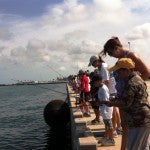Reprinted from Greenwire with permission from Environment & Energy Publishing, LLC. www.eenews.net. 202-628-6500
Laura Petersen, E&E reporter
Published: Wednesday, January 23, 2013
A loan program dedicated to helping West Coast fisheries become more sustainable earned California’s top environmental honor.
The California Fisheries Fund received the Governor’s Environmental and Economic Leadership Award, which recognizes individuals, organizations and businesses for finding innovative ways to protect natural resources while also strengthening the economy.
“It fits perfectly into the kind of themes the governor has chosen to promote,” said Jim Marxen, a spokesman for the California Environmental Protection Agency, which handed out 17 awards last night. “Good environmental practices and a healthy economy must live together, and really this project is an epitome of that.”
The $4 million fund, which began in 2008 with support from the state and foundations, provides loans to fishermen, processors and distributors to finance upgrades that result in more sustainable practices.For example, fisherman Steve Fitz recently received a loan to purchase his uncle’s boat and continue the family tradition of using Scottish seine fishing gear, which herds ground fish into light nets that are far gentler on the surrounding habitat and reduces bycatch of other marine life.
“Money isn’t that readily available to borrow in our industry,” said Fitz, who works in Half Moon Bay. “Having access to the fisheries fund … allowed it to become a reality. Here I am, a new vessel owner.”
The fund, which is administered by the Environmental Defense Fund, has distributed $1.7 million to 11 recipients to date. Read More












